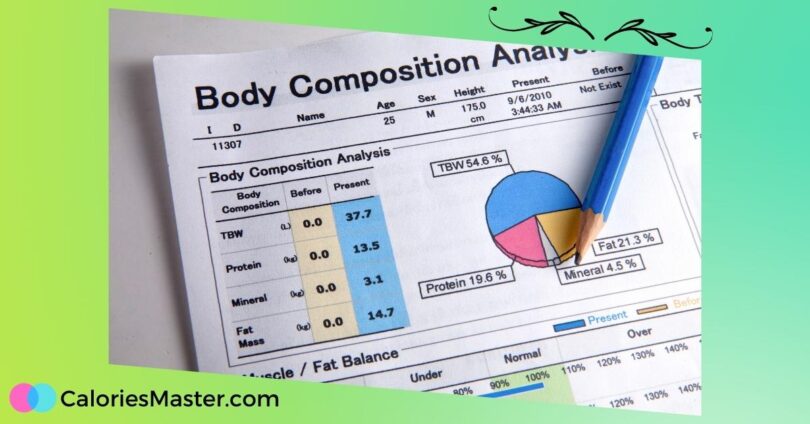Body composition refers to the proportion of fat, muscle, bone, and other tissues that make up a person’s body. It is a crucial aspect of overall health and fitness, as it can affect everything from athletic performance to disease risk.
Understanding body composition can help individuals set realistic fitness goals and make informed decisions about their diet and exercise routines.
There are several components of body composition, including body fat percentage, muscle mass, bone density, and hydration levels. Each of these factors can impact overall health and fitness in different ways.
For example, having a high percentage of body fat can increase the risk of chronic diseases such as heart disease and diabetes, while having low muscle mass can lead to weakness and poor physical performance.
Key Takeaways:
- Body composition refers to the proportion of fat, muscle, bone, and other tissues in the body.
- Understanding body composition is important for setting fitness goals and making informed decisions about diet and exercise.
- Components of body composition include body fat percentage, muscle mass, bone density, and hydration levels.
What is Body Composition?
Body composition refers to the proportion of fat, muscle, bone, and other tissues that make up a person’s body. While body weight is a simple measure of overall mass, body composition provides a more detailed understanding of a person’s health and fitness.
Body composition can be measured in a variety of ways, including:
- Bioelectrical impedance analysis (BIA)
- Dual-energy X-ray absorptiometry (DXA)
- Skinfold thickness measurements
- Air displacement plethysmography
- Hydrostatic weighing
Each method has its own advantages and disadvantages, and the choice of method will depend on factors such as cost, accuracy, and availability.
Body composition is important for several reasons. Excess body fat can increase the risk of health problems such as heart disease, diabetes, and certain types of cancer. On the other hand, having too little body fat can also be problematic, particularly for athletes and people with certain medical conditions.
Overall, maintaining a healthy body composition through a combination of regular exercise and a balanced diet is essential for optimal health and well-being.
Importance of Understanding Body Composition
Understanding your body composition is crucial for maintaining good health and achieving your fitness goals. Body composition analysis provides information about the percentage of fat, water, bone, muscle, and other lean tissues that make up your body.
By knowing your body composition, you can take steps to improve your health and fitness levels.
Health Implications
Body composition is an important indicator of overall health. Excess body fat can increase your risk of developing various health problems such as heart disease, stroke, diabetes, and some types of cancer.
On the other hand, having a healthy body composition with a higher percentage of muscle mass can improve your metabolism, reduce your risk of chronic diseases, and enhance your overall quality of life.
Fitness Levels
Body composition is also an important factor in determining your fitness levels. Knowing your body fat percentage, muscle mass, and other relevant measurements can help you set realistic fitness goals and track your progress over time.
For example, if your goal is to lose weight, body composition analysis can help you determine whether you are losing fat or muscle mass. By focusing on losing fat while maintaining or increasing muscle mass, you can achieve a healthier and more sustainable weight loss.
In summary, understanding your body composition is essential for maintaining good health and achieving your fitness goals. By regularly monitoring your body composition and making necessary adjustments to your diet and exercise routine, you can improve your overall health and well-being.
Components of Body Composition
Body composition refers to the percentage of fat, water, bone, muscle, skin, and other lean tissues that make up the body.
Understanding the different components of body composition is crucial for monitoring and improving overall health. The two main components of body composition are fat mass and non-fat mass.
Fat Mass
Fat mass is the amount of adipose tissue (fat) in the body. It is essential for energy storage, insulation, and protection of vital organs. However, too much fat mass can lead to health problems such as obesity, heart disease, and diabetes.
There are different types of fat in the body, including subcutaneous fat (under the skin) and visceral fat (around the organs). Visceral fat is more harmful to health than subcutaneous fat, as it produces inflammatory substances that can increase the risk of chronic diseases.
Non-Fat Mass
Non-fat mass is everything in the body that is not fat, including muscle, bone, organs, and water. Non-fat mass is essential for body function and movement.
Muscle mass is particularly important, as it is responsible for movement, posture, and metabolism. Maintaining or increasing muscle mass can improve overall health and reduce the risk of chronic diseases.
Bone mass is also crucial for overall health, as it provides structure and support for the body. Low bone mass can lead to osteoporosis and an increased risk of fractures.
Water is another essential component of non-fat mass, as it makes up a significant portion of the body. Adequate hydration is crucial for overall health and can improve physical performance, cognitive function, and mood.
In conclusion, understanding the components of body composition is essential for monitoring and improving overall health.
Fat mass and non-fat mass are the two main components of body composition, and both are crucial for body function and health.
Monitoring body composition can help individuals make informed decisions about their lifestyle and dietary habits to improve their health and reduce the risk of chronic diseases.
Methods to Measure Body Composition
There are several methods available to measure body composition. Each method has its own advantages and disadvantages, and the choice of method depends on the purpose of the measurement, the level of accuracy required, and the cost of the equipment.
Bioelectrical Impedance Analysis
Bioelectrical Impedance Analysis (BIA) is a quick and non-invasive method for measuring body composition. BIA works by sending a small electrical current through the body and measuring the resistance to the current.
Fat tissue has a higher resistance than lean tissue, so the BIA machine can estimate the percentage of body fat based on the resistance measurement.
BIA is a popular method because it is relatively inexpensive and easy to use. However, the accuracy of BIA can be affected by factors such as hydration levels, food intake, and exercise. Therefore, it is important to follow the instructions carefully before taking a BIA measurement.
Dual-Energy X-Ray Absorptiometry
Dual-energy X-ray absorptiometry (DXA) is a highly accurate method for measuring body composition. DXA works by sending two low-dose X-ray beams through the body and measuring the amount of radiation absorbed by the bone, fat, and lean tissue.
DXA is considered the gold standard for body composition measurement because it provides a detailed analysis of bone mineral density, fat mass, and lean tissue mass. However, DXA is expensive and requires specialized equipment and trained personnel.
Skinfold Thickness Measurements
Skinfold thickness measurements involve using calipers to measure the thickness of a fold of skin and subcutaneous fat at various locations on the body. The measurements are then used to estimate the percentage of body fat.
Skinfold thickness measurements are a simple and inexpensive method for measuring body composition.
However, the accuracy of the measurements can be affected by factors such as the skill of the person taking the measurements and the location of the measurement sites.
In conclusion, there are several methods available to measure body composition, each with its own advantages and disadvantages. The choice of method depends on the purpose of the measurement, the level of accuracy required, and the cost of the equipment.
Factors Affecting Body Composition
Body composition is determined by a variety of factors, including genetics, diet, and physical activity. Understanding how these factors affect your body composition can help you make informed decisions about your health and fitness.
Genetics
Genetics plays a significant role in determining your body composition. Some people may be naturally predisposed to carrying more body fat, while others may be naturally leaner.
However, genetics are not the only factor and do not determine your destiny. It is still possible to achieve a healthy body composition through a combination of diet and exercise.
Diet
Your diet plays a crucial role in determining your body composition. Consuming a diet high in processed and high-calorie foods can lead to an increase in body fat, while a diet rich in whole foods, lean protein, and healthy fats can help maintain a healthy body composition.
It is important to note that calorie intake also plays a role in body composition. Consuming more calories than your body needs can lead to weight gain and an increase in body fat while consuming fewer calories than your body needs can lead to weight loss and a decrease in body fat.
Physical Activity
Physical activity is another critical factor in determining body composition. Regular exercise can help build lean muscle mass, which can increase your body’s metabolic rate and help burn fat. Additionally, exercise can help improve insulin sensitivity, which can lead to a decrease in body fat.
It is important to note that the type and intensity of exercise can also affect body composition. Resistance training, for example, is particularly effective at building lean muscle mass, while high-intensity interval training (HIIT) can help burn fat and improve cardiovascular health.
In conclusion, genetics, diet, and physical activity are all important factors in determining body composition. By making informed choices about your diet and exercise routine, you can achieve and maintain a healthy body composition.
Improving Body Composition
If you’re looking to improve your body composition, balanced nutrition and regular exercise are key. Here are some tips to help you get started:
Balanced Nutrition
Eating a balanced diet is essential for improving body composition. This means consuming a variety of nutrient-dense foods in appropriate portions. Here are some tips for achieving balanced nutrition:
- Include a variety of fruits and vegetables in your diet.
- Choose lean protein sources, such as chicken, fish, and legumes.
- Limit your intake of processed foods and added sugars.
- Incorporate healthy fats, such as those found in nuts, seeds, and avocados.
- Stay hydrated by drinking plenty of water throughout the day.
Regular Exercise
In addition to nutrition, regular exercise is crucial for improving body composition. Here are some types of exercise to consider:
- Resistance training: This type of exercise helps build muscle and increase metabolism. Try lifting weights or using resistance bands.
- Cardiovascular exercise: This type of exercise helps burn calories and improve heart health. Try activities such as running, cycling, or swimming.
- High-intensity interval training (HIIT): This type of exercise involves short bursts of intense activity followed by periods of rest. HIIT can be a time-efficient way to improve body composition.
Remember, improving body composition takes time and effort. Be patient and consistent with your nutrition and exercise habits, and you will see results.









